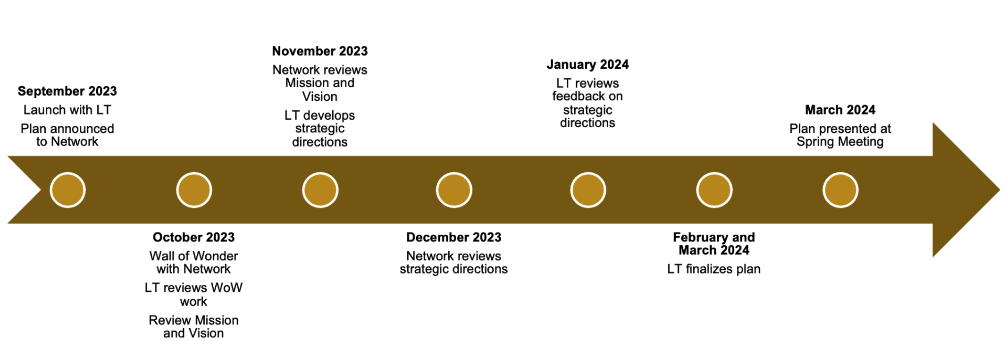In the Summer of 2023, the CIRTL Leadership Team (LT) took some time to reflect on the state of the CIRTL Network after a series of recent transitions in the Network, including leadership structure, personnel changes, updating the CIRTL Values, and modernizing network operations and decision making. The LT was left impressed with the collaborative work the Network had accomplished over the previous few years, and recognized the importance of revisiting the Mission, core ideas, foundational principles, and priorities of the CIRTL Network within a contemporary context. Since the foundation of CIRTL in 2023 as a United State National Science Foundation (NSF) funded multi-institutional project, the landscape of higher education has changed, technology has advanced, and the world survived a global pandemic that fundamentally changed our knowledge of remote teaching and learning.
Full CIRTL Strategic Plan 2024-2029 (PDF)
Process
The CIRTL Network undertook this Strategic Planning process to provide a roadmap of our hopes for the future that incorporates the needs of our member institutions, of our participating graduate students and postdoctoral researchers, and of undergraduate students who will learn in the in the classrooms of future faculty trained and mentored through CIRTL. Throughout this process we have prioritized the inclusion of stakeholder viewpoints, staying innovative and adaptable, and making sure we maintain the impact that CIRTL is known to provide.
This is intended to be a 5-year strategic plan covering the period from August 1, 2024 to July 31, 2029. The Leadership Team (LT) did not designate specific initiatives for Year 5, anticipating that those will either be a continuation of work carried over from prior years or will be determined in the future as our thinking about next steps in strategic directions naturally deepens and evolves. The LT encourages the CIRTL Network to begin a cycle of developing a new strategic plan every five years, with the next plan being developed in Fall 2028, finalized in Spring 2029 and beginning August 1, 2029.
Timeline
Strategic Directions
The Leadership Team developed seven strategic directions that considered information gleaned from the Wall of Wonder exercise and a survey that was administered to the CIRTL Network. A draft version of the strategic directions was presented to the Network for feedback in January 2024. Next to each initiative, the LT has indicated committees or other groups whose work they feel aligns with the strategic direction.
Note that if an institution is governed by laws or policies in conflict with a given strategic direction, the LT will work with the institution on how they might adjust their local implementation to allow for continued engagement in the CIRTL Network while maintaining compliance with their institutional policies. Note also that a few ideas arose that felt premature to include in this strategic plan. They are included in the next section as documentation for future conversation and action.
Year 1 Initiative (AY 24-25)
Review the language used to describe the Learning-through-Diversity core idea and related programming to ensure CIRTL values are communicated without limiting local institutions’ ability to participate given varied political climates (LT, LO Subcommittee).
Year 1 Initiatives (AY 24-25)
Explicitly define if CIRTL is STEM vs. expanding beyond (LT).
Evaluate and pilot (if appropriate) International CIRTL (MOG, LT).
Update or explore asynchronous program offerings (CNOG, 2-year initiative).
Year 2 Initiatives (AY 25-26)
Engage external stakeholders (government) (LT, CC).
Update and continue to develop asynchronous program offerings (CNOG, 2-year initiative).
Year 2 Initiatives (AY 25-26)
Rethink virtual General Meetings meetings to include students/postdocs (100’s of participants) (MPC).
Conduct annual focus groups of future faculty to solicit input and feedback (CNOG, CC).
Year 1 Initiative (AY 24-25)
Address the success and wellbeing aspects of a faculty pathway (i.e., politics, operations, and culture) (CNOG, CLDP Grant).
Year 2 Initiative (AY 25-26)
Create a (rotating) Change Leadership Institute amongst CIRTL institutions, eventually expanding around the country (CLDP Grant, LT).
Year 3 Initiative (AY 26-27)
Greater future faculty involvement in local and cross-network leadership and program development (LT, CNOG, 2-year initiative).
Year 4 Initiative (AY 27-28)
Greater future faculty involvement in local and cross-network leadership and program development (LT, CNOG, 2-year initiative).
Year 1 Initiatives (AY 24-25)
Determine how to better support local folks doing CIRTL work / their own PD (CC).
Expand support and developmental opportunities for local leaders (who are different from leaders from previous waves) (MOG, LT, CC).
Year 2 Initiative (AY 25-26)
Expand bi-annual workshops for advancing local LCs (such as Beyond STEM, etc.) (MPC, CC).
Year 2 Initiatives (AY 25-26)
Explore additional fee-for-service models (CC, LT).
Explore new membership categories (e.g., system schools, professional society, other organizations in which future faculty are involved (CC, LT, MOG).
Explore industrial partnerships & support (CC, LT).
Year 4 Initiative (AY 27-28)
Revisit new membership categories (e.g., system schools, professional society, other organizations in which future faculty are involved (CC, LT, MOG).
Year 2 Initiatives (AY 25-26)
Investigate ways to partner with professional organizations in which future faculty participate (CC, LT).
Develop foundation funding to bring in 5-10 MSI institutions (CC, LT).
Year 3 Initiative (AY 26-27)
Develop a mentorship model of recruiting new institutions as local junior partners (CC, LT, MOG, 2-year initiative).
Year 4 Initiative (AY 27-28)
Develop a mentorship model of recruiting new institutions as local junior partners (CC, LT, MOG, 2-year initiative).

